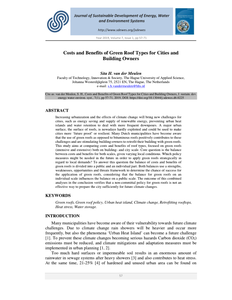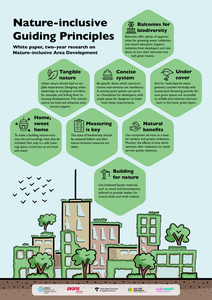Increasing urbanization and the effects of climate change will bring new challenges for cities, such as energy saving and supply of renewable energy, preventing urban heat islands and water retention to deal with more frequent downpours. A major urban surface, the surface of roofs, is nowadays hardly exploited and could be used to make cities more ‘future proof’ or resilient. Many Dutch municipalities have become aware that the use of green roofs as opposed to bituminous roofs positively contributes to these challenges and are stimulating building-owners to retrofit their building with green roofs. This study aims at comparing costs and benefits of roof types, focused on green roofs (intensive and extensive) both on building- and city scale. Core question is the balance between costs and benefits for both scales, given varying local conditions. Which policy measures might be needed in the future in order to apply green roofs strategically in regard to local demands? To answer this question the balance of costs and benefits of green roofs is divided into a public and an individual part. Both balances use a strengths, weaknesses, opportunities and threats framework to determine the chance of success for the application of green roofs, considering that the balance for green roofs on an individual scale influences the balance on a public scale. The outcome of this combined analyses in the conclusion verifies that a responsible policy and a local approach towards green roofs is necessary to prepare the city sufficiently for future climate changes. http://dx.doi.org/10.13044/j.sdewes.d6.0225
MULTIFILE

Cities worldwide are growing at unprecedented rates, compromising their surrounding landscapes, and consuming many scarce resources. As a consequence, this will increase the compactness of cities and will also decrease the availability of urban green space. In recent years, many Dutch municipalities have cut back on municipal green space and itsmaintenance. To offer a liveable environment in 30 to 50 years, cities must face challenges head-on and strive to create green urban areas that build on liveable and coherent sustainable circular subsystems.
DOCUMENT

This lessons learned report gives an overview of the output and results of the first phase of the REDUCES project. The introduction states the relevance of combining a policy approach with business model analysis, and defines the objectives. Next, an overview is given of circular economy good business practices in the regions involved. Examining these business practices helped to define the regional needs for circular economy policy. This business approach proved to be a solid base for developing regional circular economy action plans, the last chapter of this report.
DOCUMENT

More and more people worldwide live in urban areas, and these areas face many problems, of which a sustainable food provision is one. In this paper we aim to show that a transition towards more sustainable, regionally organized food systems strongly contributes to green, livable cities. The article describes a case study in the Dutch region of Arnhem–Nijmegen. Partners of a network on sustainable food in this region were interviewed on how they expect the food system to develop, and in design studies possible futures are explored. Both the interviews and the designs give support to the idea that indeed sustainable food systems can be developed to contribute to green livable cities. They show that the quality and meaning of existing green areas can be raised; new areas can be added to a public green system, and connections with green surroundings are enforced. They also show that inhabitants or consumers can be stimulated to become so called food citizens, highlighting that the relation of food systems and livable cities is a very close one.
DOCUMENT

This article will discuss philosophical debates on economic growth and environmental sustainability, the role of management responsibility, and the risk of subversion to business as usual. This discussion will be framed using the concepts of Cradle to Cradle (C2C) and Circular Economy about sustainable production. The case study illustrating the danger of subversion of these progressive models discussed here is based on the assignments submitted by Masters students as part of a course related to sustainable production and consumption at Leiden University. The evaluation of the supposedly best practice cases placed on the website of the Ellen MacArthur Foundation or those awarded Cradle to Cradle certificate has led some students to conclude that these cases illustrated green-washing. Larger implications of identified cases of green-washing for the field of sustainable business and ecological management are discussed. “This is a post-peer-review, pre-copyedit version of an article published in 'Philosophy of Management'. The final authenticated version is available online at: https://doi.org/10.1007/s40926-019-00108-x LinkedIn: https://www.linkedin.com/in/helenkopnina/
MULTIFILE

The Steenbreek program is a private Dutch program which aims to involve citizens, municipalities and other stakeholders in replacing pavement with vegetation in private gardens. The Dutch approach is characterized by minimal governmental incentives or policy, which leaves a niche for private initiatives like Steenbreek, that mainly work on behavioural change. The aim of this paper is to build a model based on theory that can be used to improve and better evaluate depaving actions that are based on behavioural change. We tested this garden greening behaviour model in the Steenbreek program. The main result is that the model provides an understanding of the ‘how and why’ of the Steenbreek initiatives. Based on this we are able to provide recommendations for the improvement of future initiatives. Steenbreek covers a wide range of projects that together, in very different ways, take into account elements of the theoretical framework; either more on information factors, or on supporting factors, sometimes taking all elements together in a single action. This focus is sometimes understandable when just one element is needed (e.g., support), sometimes more elements could be taken into account to be more effective. If a certain element of the framework is lacking, the change of behaviour will not (or will only partly) take place. The model also gives insight into a more specific approach aimed at the people most susceptible to changing their behaviour, which would make actions more effective.
DOCUMENT

This book is the account of teaching practice linked to research projects, a practice that is able to create new, unexpected values in the complex patchwork of the city through experimental and strategic interventions with greenery. That the interventions involve greenery is obviously linked to the fact that the Van Hall Larenstein university of applied sciences specializes in nature and agriculture, but there is also a practical reason. Green spaces act as a cohesive force, as is shown again and again in the Netherlands and in the Lively Cities programme. Particularly in the urban context, green spaces have a distinctive and perhaps even emotional value that encourages people to pause there and makes them think about their appreciation of a place. Greenery triggers people to take part in social experiments. But that is just the beginning.
DOCUMENT

Urban nature enhancement is a theme that needs to be considered across different scales. From pocket parks and façade-greening to urban green infrastructure, biodiversity thrives best through connectivity.In the SIA-project, Nature-inclusive Area Development, four universities of applied sciences - Aeres University of Applied Sciences, Avans University of Applied Sciences, Amsterdam University of Applied Sciences, and Van Hall Larenstein University of AppliedSciences- researched three levels of area development to accelerate the transition to nature-inclusive area development. The study consisted of three case studies: Waarder Railway Zone (building), Knowledge Mile Park (KMP - street - Amsterdam), and AlmereCentre-Pampus (area).
DOCUMENT

Electrification of transportation, communication, working and living continues worldwide. Televisions, telephones, servers are an important part of everyday life. These loads and most sustainable sources as well, have one thing in common: Direct Current. The Dutch research and educational programme ‘DC – road to its full potential’ studies the impact of feeding these appliances from a DC grid. An improvement in energy efficiency is expected, other benefits are unknown and practical considerations are needed to come to a proper comparison with an AC grid. This paper starts with a brief introduction of the programme and its first stages. These stages encompass firstly the commissioning, selection and implementation of a safe and user friendly testing facility, to compare performance of domestic appliances when powered with AC and DC. Secondly, the relationship between the DC-testing facility and existing modeling and simulation assignments is explained. Thirdly, first results are discussed in a broad sense. An improved energy efficiency of 3% to 5% is already demonstrated for domestic appliances. That opens up questions for the performance of a domestic DC system as a whole. The paper then ends with proposed minor changes in the programme and guidelines for future projects. These changes encompass further studying of domestic appliances for product-development purposes, leaving less means for new and costly high-power testing facilities. Possible gains are 1) material and component savings 2) simpler and cheaper exteriors 3) stable and safe in-house infrastructure 4) whilst combined with local sustainable generation. That is the road ahead. 10.1109/DUE.2014.6827758
DOCUMENT

Despite increased interest in applying psychological theory to the practice of designing behavioral change interventions, design professionals often lack adequate knowledge and resources to do so. In this paper, we present a tool to help professionals in the creative industries design evidence-based health interventions, the Persuasive by Design model. This paper describes the contents and application of the model as well as plans for further development and testing.
MULTIFILE
